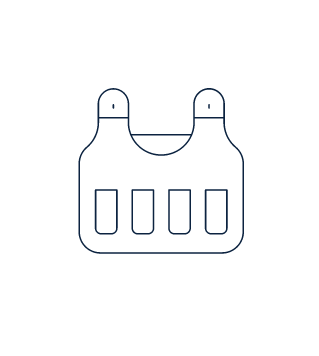
Liquid Armor
Experiment & Explore

| Ages | Cost | Time |
|---|---|---|
| 8+ | Low | About 60 minutes |
Imagine a liquid that behaved like a solid. Weird, right? Imagine what you could do with such a strange substance. In this Experiment & Explore activity, you will discover that such a substance exists, experiment with its properties, and explore how engineers might use it to solve real-world problems.
You can share your experiments with the world at #nextengineersdiy.
Things can get messy so don’t wear your favorite clothes and try to do the activity outside.
You will also need the following items to do some additional investigations.
You should have noticed that your mixture behaves differently if you handle it slowly with little force as opposed to quickly with more force. If you stir it slowly or move your hand through it slowly, it behaves much like a liquid. But if you stir it quickly or try to punch the surface, it behaves much more like a solid.
This is because the mixture you have created is no ordinary Newtonian fluid. It is a non-Newtonian fluid called Oobleck. Non-Newtonian fluids are fluids that change their viscosity (how easily they flow) under stress or force. The faster you stir or the more force you apply, the more viscous the mixture becomes.
But what is going on? There is still much that scientists and engineers don’t understand, but this is what we do know. The tiny cornstarch particles are suspended in the water rather than dissolved in it. At low speeds or small forces, the water molecules can easily fill gaps between particles as they are moved around. At higher speeds or under greater forces, the water is unable to fill these gaps and frictional forces between the cornstarch particles becomes more important. As the friction increases, the viscosity increases!
If you want to learn more about Oobleck and non-Newtonian fluids, watch the video below called Non-Newtonian Fluids (4:43)
Viscosity is a measure of how easily a liquid flows. Water has a low viscosity and flows easily. Honey has a high viscosity and does not flow easily.
A Newtonian fluid behaves as we expect normal liquids to behave. Their viscosity is constant, irrespective of the amount of force applied to them.
A non-Newtonian fluid is one which changes its viscosity depending on how much force is applied to it. For fluids like Oobleck, the greater the force, the greater the viscosity.
Knowing what you now know about Oobleck and non-Newtonian fluids, think about the following. Try these experiments yourself to see if your predictions are correct.
Oobleck sure is fun to play with, but do you think we can put its unusual properties to practical use? Consider these possibilities.

Watch these videos to learn even more about Oobleck and its amazing properties.
What is a non-Newtonian fluid and how does it work?
The Backyard Scientists experiment with their own Oobleck.
Students from Lamar University have some fun with Oobleck.
See what real students are building.